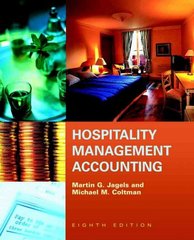Question
#1. Define the operational functions of planning, organising, leading and monitoring as a function of management and provide three examples of each in a restaurant.
#1.
Define the operational functions of planning, organising, leading and monitoring as a function of management and provide three examples of each in a restaurant.
| Function | Definition | Example |
|---|---|---|
| Planning: | ||
| Organising | ||
| Leading | ||
| Monitoring |
#2.
Complete the table with examples of five responsibilities conducted by each of the following:
| Roles | Responsibilities |
|---|---|
| Chief Executive Officer | |
| Restaurant Manager | |
| Front of house manager | |
| Head Chef | |
| Supervisors. |
#3.
Why is it important to organise work in the busy commercial kitchen?
Words:0
#4.
Mention five activities involved in work organisation in the hospitality industry.
Words:0
#5.
How do logical work flow plans and preparation lists help in work organisation?
Words:0
#6.
What five factors do work flow plans for the service of a meal take into consideration?
Words:0
#7.
Discuss any four benefits of effective planning.
Words:0
#8.
Describe any three planning tools and techniques that may be used in the operational planning process, including:
Words:0
#9.
Briefly describe the three areas or work operations that can be monitored in a hospitality organisation.
Words:0
#10.
What are four ways to monitor workplace operations?
Words:0
#11.
Mention any three types of administrative procedures a Head Chef is required to follow.
Words:0
#12.
Give three examples of OHS/WHS procedures that support work operations in the hospitality industry.
Words:0
#13.
Mention any three human resources procedures a Head Chef is required to follow.
Words:0
#14.
Briefly explain the service standards given below.
Response times -
Words:0
Service guarantees -
Words:0
Personal presentation standards -
Words:0
#15.
List three areas may be included in a restaurant's IT policy to support its work operations?
Words:0
#16.
Define standard operating procedures (SOP) and mention any three ways in which they support work operations and any three examples of SOPs specific to a restaurant.
Words:0
#17.
What is meant by 'quality assurance' and why is it important for a business?
Words:0
#18.?
Briefly explain the steps a business should take to implement Quality Assurance concepts in the workplace.
Words:0
#19.
Mention three ways a restaurant reduce their waste and carbon footprint.
Words:0
#20.
Explain the relationship between a restaurant being run efficiently and being financially sustainable. Your response should be in no more than 80 words.
Words:0
#21.
Mention five ways a chef can minimise food wastage in the kitchen.
Words:0
#22.
What is the concept of social responsibilities and how can a business incorporate this in their operations?
Words:0
#23.
Describe how a chef can manage their own time . Mention any three points.
Words:0
#24.
Describe how a head chef can ensure kitchen staff work efficiently and complete tasks on time during a service. Mention any three points.
Words:0
#25.
Briefly explain the principles of delegation.
Words:0
#26.
How can a manager delegate effectively? Mention at least four points.
Words:0
#27.
Explain how the following delegation techniques work.
Words:0
#28.
Briefly describe the steps in problem solving.
Words:0
#29.
How do you deal with a problem that has been raised by a staff member?
Words:0
#30.
Complete the table with solutions you would offer for each of the problem situations mentioned in the table.
| Problem | Solution you would implement |
|---|---|
| A customer had ordered a birthday cake but when the customer arrives with family, the chef notices that the pastry chef has forgotten to make the birthday cake | |
| Customer is kept waiting for a table for over 10 minutes | |
| The wait staff accidently spills a drink on a customer | |
| Course is not to the customer's satisfaction |
#31.
What is the difference between a programmed and a non-programmed decision?
Words:0
#32.
What categories of information does the current Hospitality award in Australia of work provide? Mention at least six.
Words:0
#33.
Complete the table with information about hours and conditions of work. The first one has been done for you as an example.
Weekly hours for full time employment 38 days
Words:0
Paid personal/carer's leave
Words:0
Regular employer contribution as a percentage
Words:0
Minimum loading on the ordinary hourly rate of pay for all standard hours
Words:0
Loading for work performed Monday to Friday between 7.00 am and 7.00 pm for casual employee
Words:0
#34.
List 4 ways a manager can ensure all staff follow OHS/WHS procedures in the workplace.
Step by Step Solution
There are 3 Steps involved in it
Step: 1

Get Instant Access to Expert-Tailored Solutions
See step-by-step solutions with expert insights and AI powered tools for academic success
Step: 2

Step: 3

Ace Your Homework with AI
Get the answers you need in no time with our AI-driven, step-by-step assistance
Get Started


